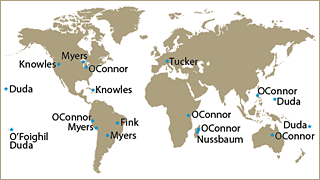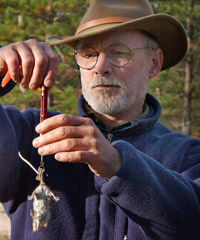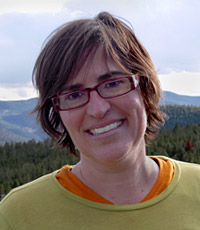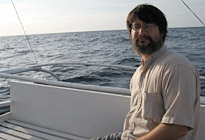Home // UM Museums // Curators in the Field // Museum of Zoology
Curators in the Field
Museum of Zoology

- William Fink
- Philip Myers
- L. Lacy Knowles
- Priscilla Tucker
- Diarmaid Ó Foighil
- Thomas Duda
- Ronald Nussbaum
- Barry OConnor
William Fink
PhD, George Washington University, 1976
Director of the Museum of Zoology; Curator of Fishes; Professor, Department of Ecology and Evolutionary Biology

Dr. Fink is a past President of the Society of Systematic Biologists, former Editor of Copeia, Founding Fellow of the Hennig Society, and was awarded the LS&A Excellence in Education Award in 1999.
Dr. Fink's research interests include biology and systematics of fishes, particularly Neotropical species, higher classification, and theory of systematics and biogeography. He is currently working on phylogenetics of piranhas, including the evolution of growth patterns and trophic specializations, and the historical biogeography of the group. He is also continuing his studies of ostariophysan fish relationships. In his phylogenetic analyses, emphasis is being placed on non-traditional characters such as ontogenetic trajectories and morphometrics.
Philip Myers
PhD , University of California, Berkeley, 1975
Curator in the Museum of Zoology; Professor, Department of Ecology and Evolutionary Biology

Myers research has shown that over the past 20 years, in response to climate change, species of mammals that once lived only in Michigan's Lower Peninsula and the southern portion of the Upper Peninsula are expanding their ranges farther north, while northern species are disappearing from all but the most northerly reaches of their ranges in the state, and in some cases, have become extinct. He studied many possible causes such as habitat and food but he believes warmer temperatures are the culprit.
Myers also founded and continues to manage the Animal Diversity Web, which contains thousands of detailed descriptions of species that have been contributed by students from more than 40 institutions in North America. ADW is one of the most widely used natural history databases worldwide, serving over five million pages to half a million users monthly.
L. Lacy Knowles
PhD: Ecology and Evolution, State University of New York at Stony Brook, 1999
Associate Curator of the Insect Division, Museum of Zoology; Associate Professor, Department of Ecology and Evolutionary Biology

Dr. Knowles' fields of study include speciation, sexual selection, phylogeography, and evolutionary radiations. Her research focuses on speciation and the processes that initiate or contribute to population divergence, and spans a wide range of temporal and spatial scales that have both ecological and evolutionary implications. Her primary research interests include the relative contributions of selection and drift to speciation, the evolution of reproductive isolation, and the processes generating macroevolutionary patterns of diversity.
A major focus of Dr. Knowles' research addresses what factors have driven the evolutionary radiation of a group of montane grasshoppers in the genus Melanoplus. Part of this work tests how the Pleistocene glaciations have affected rates of speciation and the divergence process. Patterns of genetic variation are studied in a predictive framework where alternative historical scenarios can be distinguished statistically using coalescent simulations. Another component of this research addresses whether sexual selection has played a role in Melanoplus diversification. This work uses a comparative phylogenetic approach and geometric morphometrics to test for an association between the strength of sexual selection and clade diversity.
In a separate project on species delimitation, she makes use of recent theoretical and methodological advances developed in population genetics to address the question of how species delimitation can be improved by the use of population-genetic models and explicit consideration of sampling design. With the increased use of genetic data to recognize species, the design and evaluation of genetic approaches for species delimitation is of great importance. This project couples the design and evaluation of a population genetic approach for delimiting species with an empirical application in the Caribbean cricket genus Amphiacusta, where under current methods the species boundaries differ depending on the type of data used. One of the aims of this work is to uncover the underlying determinants of this inconsistency using a statistical evaluation of whether the disagreements in species boundaries among data types reflect true conflict (i.e., discordance with the actual history of lineage splitting) or the temporal dynamic of the lineage splitting process.
Priscilla Tucker
PhD, Texas A&M University, 1984
Curator of Mammals, Museum of Zoology; Professor, Ecology and Evolutionary Biology

My research program is shaped by my interests in biological diversity and the evolutionary processes that give rise to it. More specifically, I am interested in genetic changes underlying mammalian diversity. I utilize two approaches. I conduct comparative molecular genetic studies across species to document patterns of gene evolution and then infer process. I also study genetic interactions between hybridizing species. Recent and current research is focused on species in the rodent genus Mus that are related to the laboratory mouse, a premier model for genetic studies.
Over the past decade my research group has contributed to studies on the evolution of three Y-linked genes, Sry, Smcy and Zfy, in a single genus of mouse (Mus). These studies were conducted to determine whether these genes have a different pattern of evolution from related X-linked or autosomal genes that undergo genetic recombination and are more numerous in the population.
My current major research focus is an investigation into the genetic basis of speciation between the house mouse species Mus musculus and Mus domesticus. This is a continuation of research I conducted on a naturally-occurring hybrid zone between these two species in southern Germany (Tucker, P.K. et al., 1992). I am now collaborating with Dr. Michael Nachman, University of Arizona, Jaroslav Pialek and Milos Macholan, Academy of Sciences of the Czech Republic, and Pavel Munclinger, Charles University, Prague.
Diarmaid Ó Foighil
B.Sc.(hons): Zoology, NUI Galway (Ireland), 1981; Ph.D.: Biology, University of Victoria (Canada), 1987
Curator of the Mollusk Division, Museum of Zoology; Professor, Department of Ecology and Evolutionary Biology

Diarmaid Ó Foighil was a post-doctoral fellow at the Friday Harbor Laboratories (University of Washington); Simon Fraser University (Vancouver, B.C.) and a Research Scientist at the University of South Carolina prior to joining the faculty at the University of Michigan in 1995. He has served as the president of the American Malacological Society on the editorial boards of Evolution and Malacologia.
It is an exciting time to be a biologist. Ongoing theoretical and technical advances across broad areas of biological research are greatly expanding the scope of investigation for evolutionary studies and numerous classic questions concerning the origin and maintenance of biotic diversity are now being meaningfully tested for the first time. The Mollusca are enormously diverse, have an excellent fossil record, and play central roles in almost all of the earth's ecosystems. As a result, outstanding exemplar molluscan taxa can be targeted for most primary questions in the overlapping disciplines of evolution, systematics and biogeography. Although my background has been in marine systems, since moving to Ann Arbor I have also become very interested in freshwater and terrestrial taxa and presently have research projects on marine, terrestrial and freshwater taxa.
Thomas Duda
PhD, Harvard University, 1999
Assistant Curator of Mollusks, Museum of Zoology; Assistant Professor, Department of Ecology and Evolutionary Biology

Tom Duda and the personnel in his lab in the Mollusk Division of the UMMZ are currently studying the evolution of venoms and feeding specializations of a set of closely related predatory marine gastropods at Guam, American Samoa, Hawaii and Easter Island. They use field studies, microscopy, and molecular evolutionary approaches to understand the molecular genetic basis of ecological adaptations.
Ronald Nussbaum
Ph.D.: Zoology, Oregon State University, 1972
Curator of the Division of Reptiles and Amphibians, Museum of Zoology; Professor, Department of Ecology and Evolutionary Biology

Dr. Nussbaum is interested in the systematics, evolution, and ecology of amphibians and reptiles. He has published extensively on the the systematics of caecilians (Amphibia: Gymnophiona). His field research and curatorial activities have been focussed on the Pacific Northwest (U. S. and Canada), the Seychelles Archipelago, and recently Madagascar. His work in Madagascar involves biodiversity surveys of amphibians, reptiles, and small mammals in the diminishing forests of that large island. Much of his research is related to conservation issues, and he is director of an IUCN-Species Survival project aimed at assessing the status of the amphibian fauna of Madagascar and the Seychelles Archipelago. Dr. Nussbaum has had a long and continuing interest in the evolution of partental care, parental investment, demography, and life history strategies.
Barry OConnor
B.S. (with distinction): Zoology, Iowa State University, 1971; Ph.D.: Entomology (Acarology), Cornell University, 1981
Curator of Insects, Museum of Zoology; Professor, Department of Ecology and Evolutionary Biology

I was a post-doctoral fellow at the University of California, Berkeley. I have subsequently served as a visiting professor at Ohio State University (Acarology Summer Program), and the Escuela Nacional de Ciencias Biologicas, Instituto Politecnico Nacional, Mexico City, Mexico.
My research focuses on the evolution and ecology of parasitic and commensal mites and vertebrate, invertebrate, plant and fungal hosts. Taxonomic foci include the Astigmatid and Dermanyssoid mites. Geographic foci have included Southeast Asia, Madagascar, East Africa and other regions.

